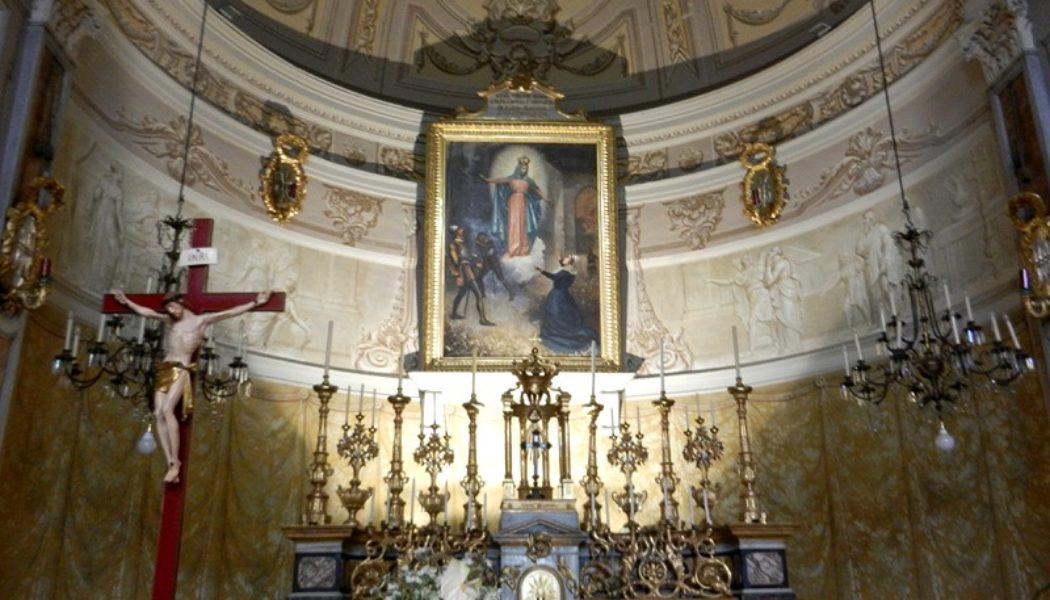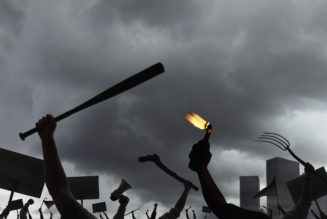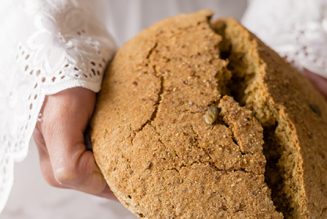
Christmas miracles do happen. One took place during the 12 days of Christmas 682 years ago — a miracle that has repeated every year since then except for the merest fraction of times. With the event came another title for our Blessed Mother — Our Lady of the Flowers.
To be exact, the miracle took place on the evening of Dec. 29, 1336. The place: on the outskirts of Bra, Italy, which is on the road to Turin, where the Shroud of Turin is housed, 27 miles to the north.
A young wife named Egidia Mathis, who was expecting the couple’s first child, was walking home that winter evening. As she approached one of the pillars on the road on which was frescoed a picture of the Blessed Virgin Mary with the Christ Child, she spotted two mercenaries nearby. Egidia was frightened by their threatening glares and instinctively sensed the intent of these hired soldiers was to harm her. She ran to Our Lady pictured on the pillar — a Mother who gave birth to the Christ Child at this time of year — and pleaded for help.
A light shone from the pillar, as Our Lady appeared. As Mary looked at the foreign mercenaries and waved them off, they quickly ran away, frightened. Our Lady then smiled at Egidia and comforted her, one Mother to her child who was soon to be a mother herself — sooner than expected, in fact. The stress and emotional intensity of the scary situation caused the young woman to give birth to her baby immediately.
The vision and birth were not the only happy happenings. A nearby hedgerow of leafless blackthorn bushes circling the area around the pillar were clothed in ice — until the hedgerow burst into bloom, covered in white flowers, thousands of them, as if the bushes were heralding two events — the celebration of new life from Mother and mother.
Egidia ran home with her newborn child, excited to tell everyone what had just happened. She described the event to her husband, and he told their relative and friends; everyone shared the amazing story of the appearance of our Blessed Mother and of the miracle of the blackthorn bushes with their neighbors, and the whole town ran out to see the miracle of Madonna dei Fiori (Our Lady of the Flowers).
Every year since, the blackthorns at this same location flower between Dec. 25 and Jan. 15. Exceptionally rare exceptions were 1914 and 1939, the years both World Wars began, as if heaven were telling the world through the miraculous bushes that a winter of war was coming.
Since then, the yearly blooming, out of season, has left scientists and botanists scratching their heads, as the old saying goes. The first examinations of the blackthorns began in 1700 and continued on through the years, including experts from the Botanical Garden of the University of Turin.
The studies have revealed that the blackthorn, a form of wild plum, is supposed to have only one flowering, always in the spring, sometime between March and April; the soil where these miraculous blooms occur is the same quality as other areas, so no abnormal underground or other causes have been detected.
Here is something else to think about: The blackthorn’s botanic family name is Rosaceae. In other words, it’s of the rose family, which has long been associated with Our Lady.
Pilgrims Lead to Sanctuaries
The constant flow of pilgrims prompted a small church to be erected by the pillar. Since the stream of pilgrims never stopped, but rather increased, in the year 1626 what is now the old church, called the “Ancient Sanctuary,” was built to replace the first modest church. Devotion to Madonna dei Fiori, Our Lady of the Flowers, continued to grow and blossom over the years and centuries so that, in 1844, the church had to be modified again. With devotion itself continuously in bloom and always growing, the “New Sanctuary” was built in 1933.
The “Ancient Sanctuary” remains, and one of its side chapels contains a more recent statue of the Madonna dei Fiori. In another side chapel is the painting of the Madonna dei Fiori, Our Lady of the Flowers, completed in 1638 by Flemish artist Jean Claret, a favorite painter in the local area, shortly after this edifice opened. It presents Our Lady on a cloud with the Child Jesus, who holds roses in his hand. The cloud floats above a large urn of flowers. Angels fly about and dance around the flowers in the depiction, too.
In the main sanctuary, the large painting over the altar highlights the traditional scene of the first miracle, showcasing, in the image, Egidia imploring the Blessed Mother for help while the two frightened mercenaries are about to flee.
A similar large oil painting rises over and above the main altar in the New Sanctuary. In this rendition, while Egidia is shown again imploring the Blessed Mother for help, her arms are also stretched out toward Our Lady in thanksgiving, as the mercenaries are already gone.
The sanctuary also enshrines a statue of Our Lady of the Immaculate Conception — the third one patterned after the original — that is annually carried in procession through the city of Bra on Sept. 8, which is not only the major feast of the Nativity of Mary, but also in this city the patronal feast of the Madonna dei Fiori. This annual procession began in the early 18th century after the area was struck in 1742 by the plague and citizens promised to fast on bread and water until the vigil of the Nativity of Mary as well as to commission a statue of her. The plague subsided, and they made the life-size statue, this one adapted as Our Lady of the Flowers, as in her left hand she holds a flowering branch of the blackthorn bush.
The Ever-Blooming Christmas Message
The Sanctuary of the Madonna dei Fiori offers an interpretation of one of the messages of the continuing miracle — a timeless message for Christmas and all seasons.
The online message explains that Our Lady appeared “to defend the dignity of a woman and care for the nascent life,” something she always does. Mary is the Mother of Christ, all disciples, and Mother of the Church. The blackthorn blooming yearly in winter, and spring, “is, in turn, a sign of our Christian life that must always flourish where we are, even when the circumstances are adverse or we are going through times of difficulty.”
It adds, “Our Lady always invites us and sustains us in welcoming the Gospel invitation to conversion through the sacrament of reconciliation, sister of baptism, to nourish us with the Word of God, the Eucharist and to persevere in prayer.”
Indeed, these are Christmas miracles that can “bloom” for the faithful every day of the year.
Join Our Telegram Group : Salvation & Prosperity







